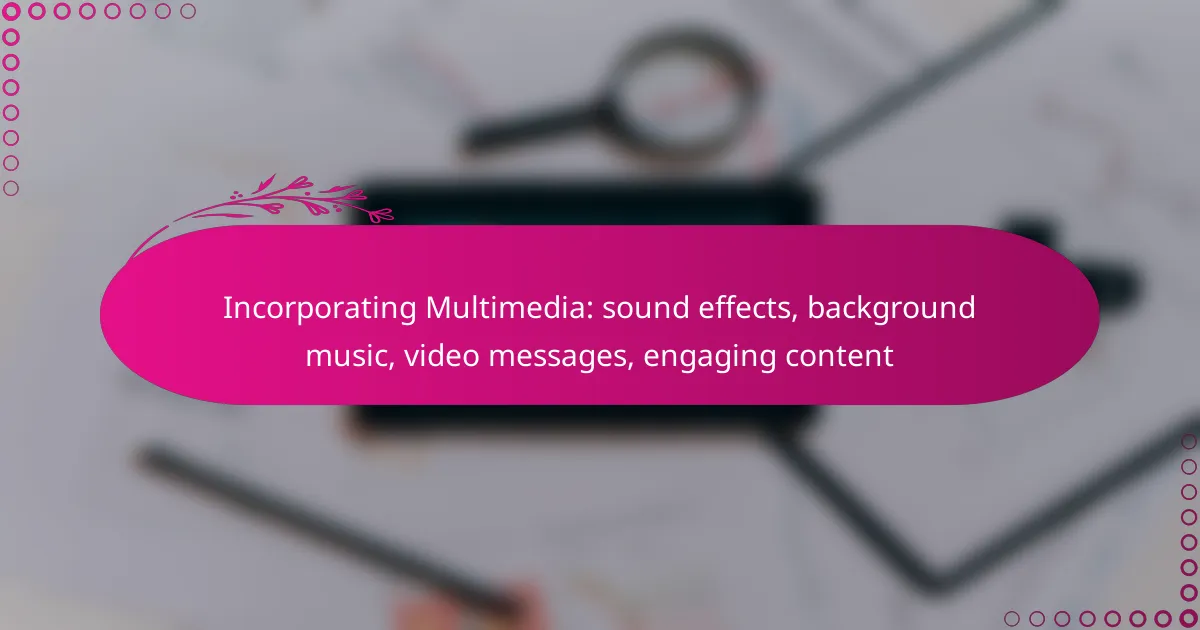Incorporating multimedia elements such as sound effects, background music, and video messages can significantly enhance audience engagement and improve the overall experience. By carefully selecting audio and visual components, you can evoke emotions, reinforce your message, and create memorable content that resonates with your audience. Effective communication through these elements not only captivates viewers but also ensures that your message is delivered succinctly and impactfully.
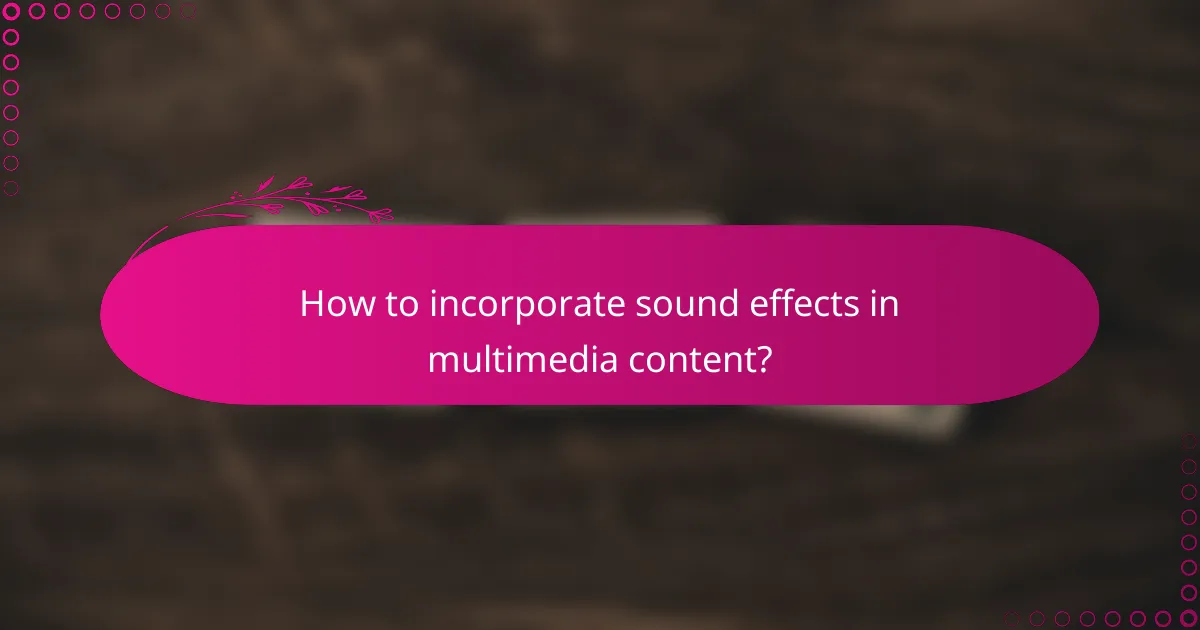
How to incorporate sound effects in multimedia content?
Incorporating sound effects into multimedia content enhances engagement and improves the overall experience. Effective use of sound can evoke emotions and reinforce messages, making your content more memorable.
Use royalty-free sound libraries
Royalty-free sound libraries provide a vast collection of sound effects that can be used without incurring additional fees after the initial purchase. Websites like Freesound, AudioJungle, and Epidemic Sound offer diverse options suitable for various projects.
When selecting sound effects, ensure they match the tone and purpose of your multimedia content. For instance, a horror-themed project may benefit from eerie sounds, while a corporate video might require more neutral, professional audio clips.
Integrate sound effects with tools like Adobe Audition
Software such as Adobe Audition allows for precise integration of sound effects into your multimedia projects. You can import sound files, edit them, and synchronize them with visuals to create a cohesive experience.
Utilize features like multi-track editing to layer sound effects with background music and dialogue. This approach helps maintain clarity and ensures that each element complements the others, enhancing the overall impact.
Optimize sound levels for clarity
Optimizing sound levels is crucial for ensuring that sound effects are clear and do not overpower other audio elements. Aim for a balanced mix where sound effects enhance rather than distract from the main content.
A common practice is to keep sound effects at a lower level than dialogue, typically around -10 to -15 dB, to maintain intelligibility. Regularly test your audio on different devices to ensure it sounds good across various platforms, from smartphones to desktop speakers.
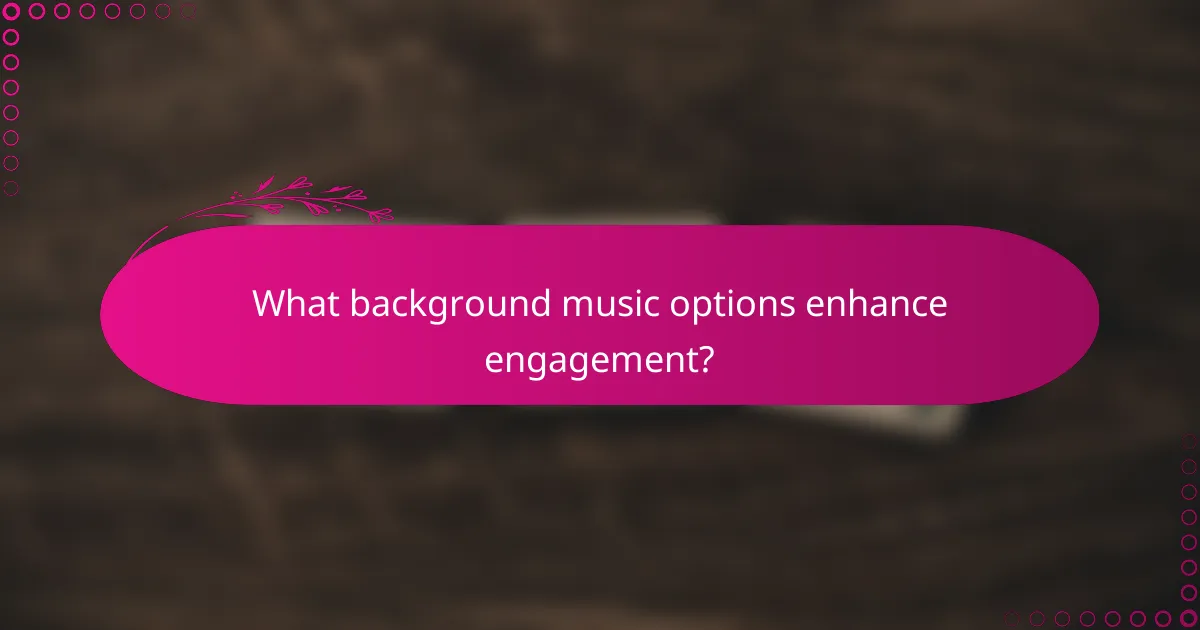
What background music options enhance engagement?
Background music can significantly enhance engagement by setting the right mood and keeping the audience interested. Selecting the appropriate music options involves considering the content type, audience preferences, and the overall message you want to convey.
Choose music from platforms like Epidemic Sound
Platforms such as Epidemic Sound offer a vast library of royalty-free music that can elevate your content. These services provide various genres and styles, making it easier to find tracks that resonate with your audience. Subscription models typically allow unlimited access to their music catalog, which can be a cost-effective solution for creators.
When selecting music, ensure that it aligns with your brand identity and the emotions you want to evoke. For instance, upbeat tracks work well for promotional content, while softer melodies may suit educational videos.
Utilize AI-generated music for customization
AI-generated music tools allow creators to customize soundtracks based on specific needs. These platforms can generate unique compositions tailored to the length, mood, and style of your content. This level of personalization can enhance the viewer’s experience and make your content stand out.
Consider using AI music generators if you require original scores or want to avoid licensing issues. Many of these tools offer user-friendly interfaces, enabling quick adjustments to tempo and instrumentation.
Match music tempo with content pacing
Aligning the tempo of your background music with the pacing of your content is crucial for maintaining engagement. Fast-paced music can energize action-packed videos, while slower tracks may complement reflective or narrative-driven content. This synchronization helps create a cohesive viewing experience.
As a rule of thumb, assess the rhythm of your visuals and choose music that enhances the intended emotional response. For example, a tutorial might benefit from steady, calm music, while a promotional video could use lively, upbeat tracks to create excitement.
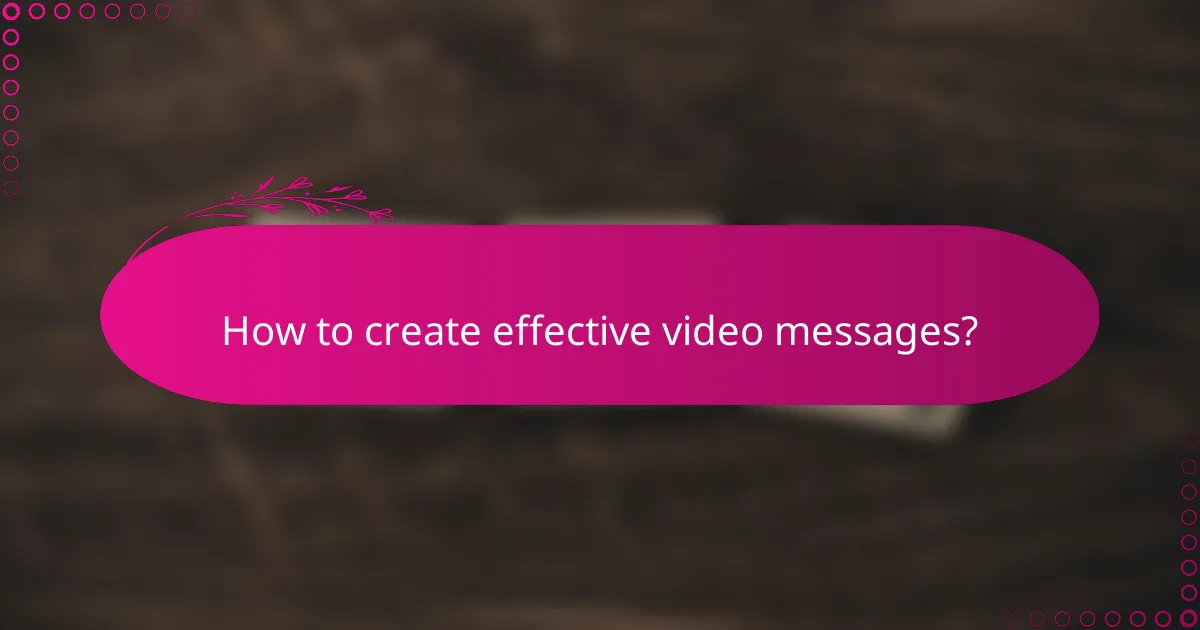
How to create effective video messages?
Creating effective video messages involves clear communication, engaging content, and the right tools. Focus on delivering your message succinctly while incorporating multimedia elements that enhance viewer engagement.
Use tools like Camtasia for editing
Camtasia is a powerful video editing tool that simplifies the process of creating professional-looking video messages. It offers features such as screen recording, video effects, and easy-to-use editing capabilities, making it suitable for both beginners and experienced users.
When using Camtasia, take advantage of its templates and built-in assets to streamline your workflow. This can save time and ensure a polished final product. Consider exploring other tools like Adobe Premiere Pro or Final Cut Pro if you need more advanced features.
Incorporate storytelling techniques
Storytelling techniques can significantly enhance the impact of your video messages. Start with a compelling hook to grab attention, followed by a clear narrative structure that includes a beginning, middle, and end. This approach helps maintain viewer interest throughout the message.
Use relatable characters or scenarios to connect with your audience emotionally. Incorporating personal anecdotes or case studies can make your message more memorable and engaging. Remember to keep the story relevant to the core message you want to convey.
Ensure high-quality visuals and audio
High-quality visuals and audio are crucial for effective video messages. Invest in a good camera and microphone to ensure clear video and sound. Poor quality can distract viewers and undermine your message.
When recording, pay attention to lighting and background noise. Natural light is often the best choice for video, while using a quiet space can enhance audio quality. Always review your footage before finalizing to ensure it meets your standards for clarity and professionalism.

What are the best practices for engaging content?
To create engaging content, focus on interactivity, personalization, and data-driven strategies. These practices enhance user experience and encourage audience participation, making your content more memorable and impactful.
Utilize interactive elements like polls
Incorporating interactive elements such as polls can significantly boost user engagement. Polls invite users to share their opinions, making them feel involved and valued. Consider using tools that allow for real-time results, which can further stimulate discussion and interaction.
When designing polls, keep questions clear and concise. Aim for a balance between open-ended and multiple-choice formats to capture a range of responses. Regularly update polls to reflect current trends or topics relevant to your audience.
Incorporate user-generated content
User-generated content (UGC) is a powerful way to enhance engagement by showcasing your audience’s creativity and perspectives. Encourage users to submit photos, videos, or testimonials related to your brand, which can foster a sense of community and trust.
To effectively integrate UGC, create specific campaigns or hashtags that users can follow. Highlighting this content on your platforms not only enriches your offerings but also motivates others to participate, increasing overall engagement.
Leverage analytics for content optimization
Using analytics is crucial for optimizing content and ensuring it resonates with your audience. By tracking metrics such as engagement rates, click-through rates, and user behavior, you can identify what works and what needs improvement.
Regularly review analytics data to adjust your content strategy. Focus on high-performing topics and formats, and consider A/B testing different approaches to refine your content further. This data-driven method can lead to more effective engagement strategies over time.
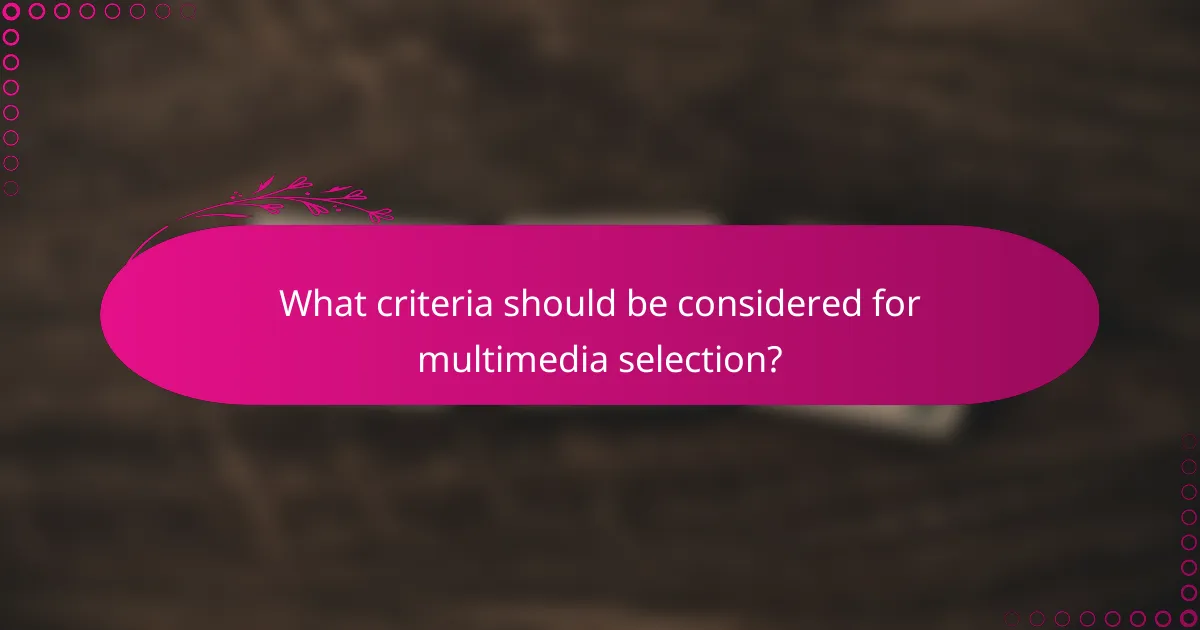
What criteria should be considered for multimedia selection?
When selecting multimedia elements like sound effects, background music, and video messages, consider audience preferences, platform compatibility, and the overall engagement potential of the content. These factors ensure that the multimedia enhances the message and resonates with viewers.
Assess audience preferences and demographics
Understanding your audience’s preferences and demographics is crucial for effective multimedia selection. Consider factors such as age, cultural background, and interests, as these can significantly influence the type of sound effects or music that will resonate.
For instance, younger audiences may prefer upbeat, contemporary music, while older demographics might appreciate classic tunes. Conducting surveys or analyzing engagement metrics can provide insights into what your audience enjoys.
Evaluate platform compatibility
Different platforms have varying requirements and best practices for multimedia content. Ensure that your chosen sound effects, background music, and video formats are compatible with the platforms where your content will be shared.
For example, social media platforms like Instagram and TikTok may favor short, catchy clips, while YouTube allows for longer videos with richer soundscapes. Always check the technical specifications, such as file size and format, to avoid playback issues.
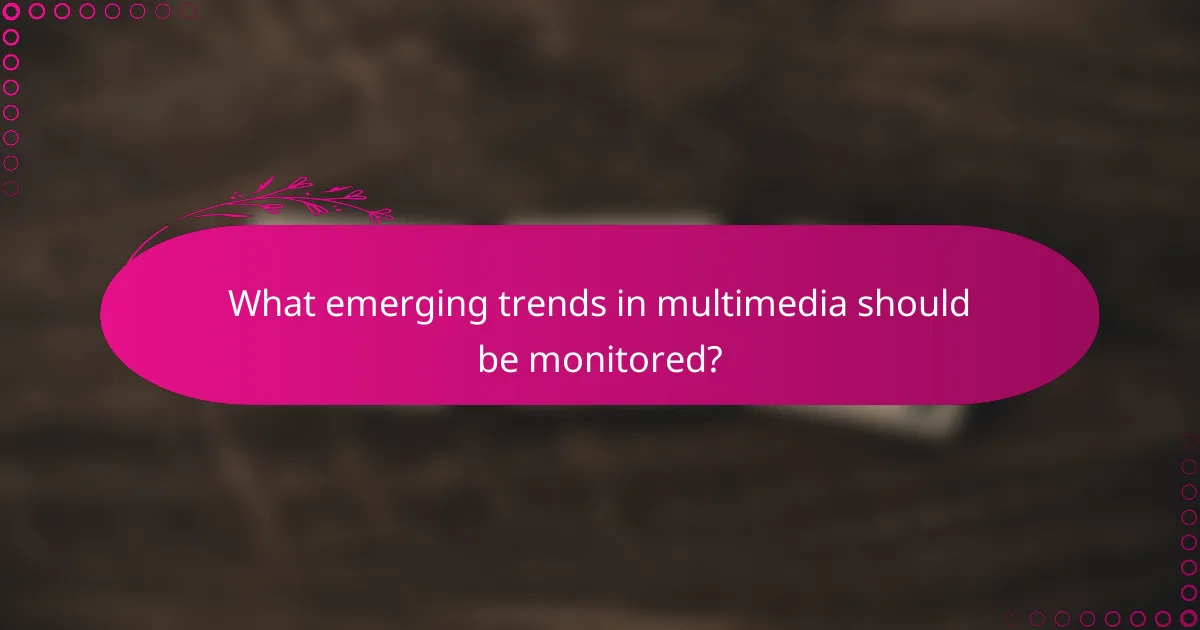
What emerging trends in multimedia should be monitored?
Emerging trends in multimedia include the increasing use of interactive content, personalized audio experiences, and the integration of augmented and virtual reality. These trends enhance user engagement and create immersive experiences that can significantly impact how information is consumed.
Interactive Content
Interactive content, such as quizzes, polls, and interactive videos, engages users more effectively than static formats. This type of multimedia encourages participation, leading to higher retention rates and deeper connections with the audience. For example, brands using interactive videos can see engagement rates that are significantly higher than traditional video formats.
To implement interactive content, consider tools like H5P or Outgrow, which allow for easy creation of engaging multimedia experiences. Keep in mind that simplicity is key; overly complex interactions can frustrate users and detract from the overall experience.
Personalized Audio Experiences
Personalized audio experiences, including tailored playlists and customized soundscapes, are becoming increasingly popular. These audio formats cater to individual preferences, enhancing user satisfaction and engagement. For instance, platforms like Spotify utilize algorithms to create personalized playlists that resonate with users.
When incorporating personalized audio, consider user data and preferences to create a more relevant experience. Avoid overwhelming users with too many choices; instead, offer curated options that align with their interests.
Augmented and Virtual Reality Integration
Augmented reality (AR) and virtual reality (VR) are transforming multimedia by providing immersive experiences that blend digital content with the real world. These technologies can be particularly effective in education, training, and marketing, allowing users to interact with products or concepts in a three-dimensional space.
To effectively utilize AR and VR, ensure that the technology aligns with your audience’s capabilities and access. Consider the cost of development and the necessary hardware, as not all users may have access to the latest devices. Start with simple applications to gauge user interest and gradually expand your offerings based on feedback.
